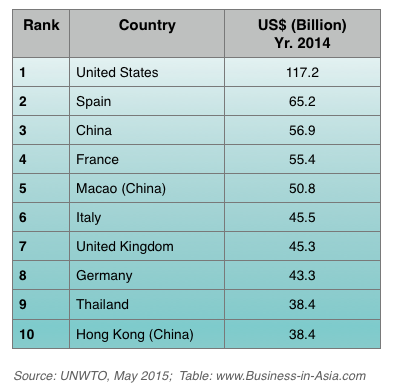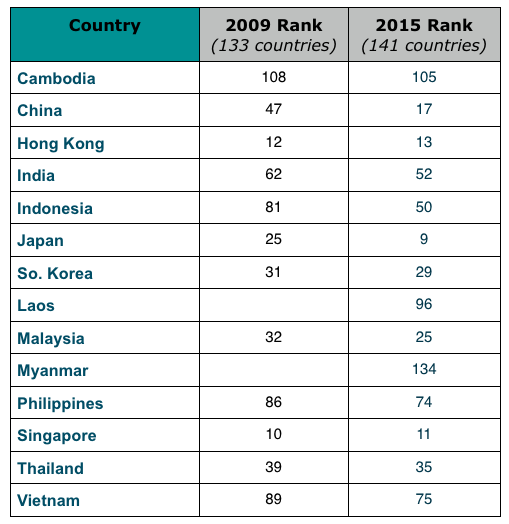Asia Tourism – healthy growth, with few exceptions

The The World Tourism Organization (unwto.org), the United Nations specialized agency mandated with the promotion of responsible, sustainable and universally accessible tourism, reported that in 2014, Asia and the Pacific, which make up 30% of the total, welcomed 263 million international tourists, up 14 million from 2013 (+5%). The region earned US$ 377 billion in tourism receipts, up by US$ 16 billion over 2014 (+4% in real terms).
“International tourism is an increasingly significant component of international trade as seen in export earnings from international tourism and passenger transport, which reached $1.5 trillion in 2014,” UNWTO secretary-general Taleb Rifai said. “With decreasing commodity prices, spending on international tourism grew significantly in 2014, proving the sector’s capacity to stimulate economic growth, boost exports and create jobs.”
As a worldwide export category, tourism ranks fourth after fuels, chemicals and food but ranks first in many developing countries.
Top 10 World Tourism Arrivals and Receipts:
Asia and the Pacific accounts for 23% of worldwide arrivals and 30% of receipts. Receipts include, entering to the country of the international visitors and spending on accommodation, food and drink, entertainment, shopping and other services and goods. (In real terms: taking into account exchange rate fluctuations and inflation)
Major destinations in Asia and its percentage growth in 2014 are:
- Myanmar posted 51% growth - arrivals surged in another year of remarkable growth
- Japan posted 29% growth
- South Korea 17% growth
- India posted 11% growth
- Hong Kong posted 8% growth
- Malaysia, Indonesia and Cambodia also posted solid growth, each posted at 7% growth figure
- Vietnam saw a 4% growth
- Growth was flat in Singapore (+0%) and China (+0%). However, in terms of tourism earnings, China climbed to third place from fifth following a 10% increase in earnings.
However the average score was weighed down by subdued results in major destinations:
- Thailand (-7%), largely due to the political unrest at the beginning of 2014, following 4 years of double-digit growth. However, Thailand is still on the top 10 International Tourism Receipt list. For Arrival, Thailand’s place in the 10th position was taken over by Mexico in 2014.
Top Asia Spender in International Tourism:
The World Tourism Organization’s report noted that China has been by far the fastest growing source market in recent years and has been the world’s top spender in international tourism since 2012. In 2014, China continued its exceptional pace of growth with a 28% increase in expenditure in 2014, reaching a total of US$ 165 billion – an exceptional 27% increase over 2013 and US$ 36 billion more in absolute terms. Boosted by rising disposable incomes, an appreciating currency, improved travel facilitation and an easing of restrictions on foreign travel, Chinese outbound travel has been growing exponentially over the last two decades. China currently generates some 13% of global tourism receipts, benefitting many destinations around the world, particularly in Asia and the Pacific, according to UNWTO. Other Asia source markets showed double-digit growth in tourism expenditure including: India, the Philippines and Thailand.
Travel & Tourism Competitiveness 2015
The Travel and Tourism Competitiveness Index Report (TTCI) is the biennial report published by the World Economic Forum. Starting since 2007, it covered 124 major and emerging economies - in recent years the report expanded to 141 countries. The Travel and Tourism Competitiveness Report provides measurement of the factors that make it attractive to develop business in the travel and tourism industry of individual countries (not a measure of a country's attractiveness as a tourist destination).
The Travel and Tourism Competitiveness 2015 Report ranks 141 countries across 14 separate dimensions, revealing how well countries could deliver sustainable economic and societal benefits through their travel and tourism sector. The index is made of three main subindexes: 1) regulatory framework 2) business environment and infrastructure; 3) human, cultural, and natural resources. Below are countries in Asa’s rankings for 2015 and their progress since 2009.
The World Economic Forum’s Travel & Tourism Competitiveness Index 2015 Ranking
According to the report, the most significant growth in international arrivals is observed in South-East Asia, thanks in part to its region’s price competitiveness and the rapid expansion of its middle class. Developing regional cooperation on visa policies could further boost tourism, though investments are also needed in digital connectivity, infrastructure and protection of rich but depleting natural capital.
The top five performers in the Asia-Pacific are among the region’s more advanced economies: coming in 2nd place after Australia was Japan (9th), then Singapore (11th), Hong Kong SAR (13th) and New Zealand.
Japan named world's ninth most tourist friendly country, a major improvement. The country rose five spots from a 14th place in the previous compilation of the ranking which took place in 2013. “Japan’s human resources are highly qualified and excel in terms of treatment of customers, where Japan is ranked first globally,” the WEF said.
Hong Kong continues to excel in three areas, the report found. It has the best ground and port infrastructure globally, with a score of 6.5, and comes second in terms of business environment and readiness of information and communications technology. But the city has dropped considerably since 2011 in its ranking for price competitiveness. It came in at 127th, down from 32nd in 2013 and 67th in 2011. The sub-index is measured by looking at factors such as fuel prices, hotel rates, ticket prices and purchasing power parity.
India has moved up 10 points to the 52nd position on a list of countries in terms of their travel and tourism competitiveness. "India takes the 52nd place overall. T&T (travel and tourism) already accounts for 5 percent of India's employment and its huge potential for further growth is made visible by comparing the country's 7 million international visitors to China's 55 million," said the report. The report also highlights that India's long-standing infrastructure gaps remain. Plus, India lags behind on health and hygiene (106th) and information, communications and technology readiness (114th).
The Philippines scored generally high in the areas of international openness and price competitiveness, but fared lower in safety and security, health and hygiene,
While the WEF ranked Thailand 10th overall in the Southeast Asia region, it scored last, behind even Myanmar and the Philippines, in terms of "safety and security” due to its political turmoil, ultimately reducing the overall ranking.
Vietnam’s tourism environment (security, health care, sanitation) reaches 4.6 out of 7 points, policy (3.7 points), and natural and cultural resources (2.9 points). Infrastructure is evaluated at the lowest level among four criteria. Although Vietnam has not made many breakthroughs, it has jumped in the TTCI ranking in recent years from 89th/140 countries in 2009 to 80th in 2011 and 2013.



Follow us on Twitter: @InsightNewsAsia
Copyright © 2015: Runckel & Associates, Inc
Visit our other website: Asia-Art.net



|
|